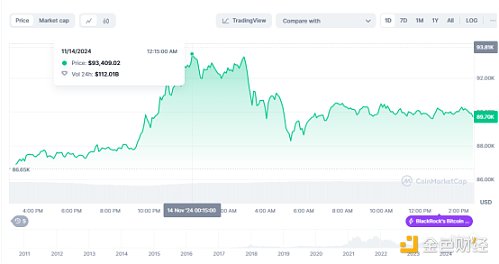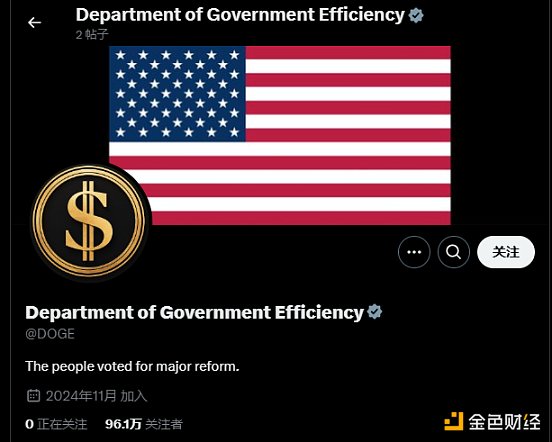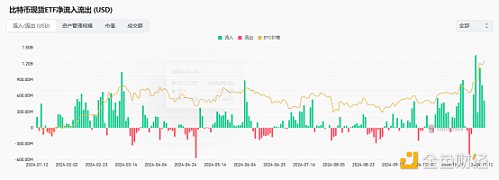It took Bitcoin only one week to go from $70,000 to $90,000. Just this morning, Bitcoin hit a new high, rising all the way above the $90,000 mark, reaching a high of more than $93,000, just one step away from the $100,000 predicted by analysts.
The bull market is emerging, the crypto world is boiling, and the news is naturally burning. Can the rise continue? How far can the Trump effect go? The market is also divided.
Before the election, Bitcoin surged to $74,000. At that time, there were still doubts in the market, and the voices of bearishness and conservatism were still there, but the facts proved that the Trump effect is more worth looking forward to than imagined.
In the early hours of this morning, Bitcoin rose nearly 6% during the day, officially standing above $90,000, reaching a high of $93,462. Although it subsequently fell back to $90,000, as of now, Bitcoin has risen by more than 33% since the US election. After breaking through $93,000, the market value of Bitcoin rose to $1.84 trillion in a short period of time, surpassing Saudi Aramco and once rising to the seventh place in the world's mainstream assets.

The crypto market also boiled, with the market value of USDT breaking through $127.84 billion, setting a record high. Most mainstream sectors rose, and new coins such as PUNT in the MEME sector continued to rise. In the early morning, US stocks of cryptocurrency concept stocks collectively rose, MicroStrategy rose more than 4%, Coinbase rose 3.7%, Riot Blockchain rose 2%, and the Hong Kong stock crypto sector also continued to rise, with OKEx Cloud Chain rising more than 10%.
The same volatility brings the same liquidation formula. Coinglass data shows that as of early this morning, the 24-hour cryptocurrency market had a total contract liquidation of US$659 million, of which long orders were liquidated for US$374 million and short orders were liquidated for US$284 million. The total amount of BTC liquidation was US$161 million, and the total amount of ETH liquidation was US$87.1368 million.
As for the reasons for the rise, Trump's agenda and the Fed's policy outlook are the main support for the positive, but on the other hand, the bullishness of large institutions and the popularization of national reserves have also become important reasons.
From the perspective of the Federal Reserve, after cutting interest rates by 25BP in November, lowering the federal benchmark interest rate to 4.5%-4.75%, the market has been cautious about the extent of subsequent interest rate cuts, especially as Trump's policy philosophy has obvious hidden dangers of pushing up inflation. However, the CPI data released yesterday made the interest rate cut more feasible. Data released on Wednesday showed that the US CPI rose 2.6% year-on-year and 0.2% month-on-month in October; the core CPI (excluding volatile factors such as energy and food) in October rose 3.3% year-on-year and 0.3% month-on-month; showing that the non-agricultural data in October, which was disturbed by hurricanes and was less than expected, was combined with inflation in line with expectations.
Against this backdrop, traders have increased their bets on the Federal Reserve to continue to cut interest rates next month. According to CME Fed Observation, the probability of the Fed maintaining the current interest rate unchanged by December is 17.5%, and the probability of a cumulative interest rate cut of 25 basis points is 82.5%. The probability of maintaining the current interest rate unchanged by January next year is 11.9%, the probability of a cumulative interest rate cut of 25 basis points is 61.7%, and the probability of a cumulative interest rate cut of 50 basis points is 26.5%.
The loose environment seems to be able to continue, and the prices of risky assets have been pushed up. But it is more noteworthy that the current rise in the crypto market is undoubtedly highly dependent on the favorable regulatory expectations brought by Trump. The new official took office with three fires. Just a few days ago, Trump began to update his agenda and personnel changes after taking office.
As president, Trump needs to nominate 15 departmental cabinet members. Musk and Robert Kennedy Jr. are undoubtedly highly related to encryption. Although Robert Jr. has not yet taken office, the boots of the government efficiency department have already fallen. Trump announced that Musk and Vivek Ramaswamy will jointly lead the proposed "Ministry of Government Efficiency", and said that the agency will pave the way for dismantling government bureaucracy, cutting redundant regulations and wasteful spending, and restructuring federal agencies.

Musk forwarded the appointment on the social platform, saying that the Ministry of Government Efficiency is not a threat to democracy, but a threat to bureaucracy. The efficiency of the Ministry of Government Efficiency is also very fast. Today, the official X account of the Ministry of Government Efficiency has been officially launched, and Musk's support for encryption is no less. In addition to releasing a LOGO with the word DOGE, he also responded to @DOGE on the official account, which also added fuel to the DOGE community.
On the SEC side, which is the most concerned by the market, from a regulatory point of view, the president cannot remove Gensler from the committee without a legitimate reason, and Gensler himself does not seem to have the intention to resign on his own. However, Trump still hinted that he would bypass the Senate's appointment confirmation procedure to appoint members of his government. If this statement is true, the probability of Gensler's position being lost will be greatly increased. On the other hand, the majority leader of the US Senate will be Senator John Thune, who supports crypto legislation, next year, which also lays a solid foundation for the policy direction.
Although from the current agenda announced by Trump, the first day of work will start with the relatively easy large-scale deportation of illegal immigrants living in the United States, and cryptocurrencies are not included, but as pro-crypto members continue to join the ruling party, the long-term deterministic benefits are clearly visible. For example, Ripple's legal officer, who has suffered from regulatory influence, believes that the new government will withdraw digital asset cases, and market sentiment is agitated.
Unexpectedly, large institutions are optimistic about the real money. MicroStrategy was the first to bear the brunt. On the evening of November 11, MicroStrategy announced that it had purchased 27,200 bitcoins between October 31 and November 10, spending about $2.03 billion, with an average purchase price of about $74,463 per bitcoin. The funds for this purchase came from the company's ATM stock sales activities. Currently, MicroStrategy's total holdings have reached 279,420 bitcoins, with a total purchase cost of about $11.9 billion and an average purchase price of about $42,692 per bitcoin.
Wall Street is not to be outdone. Following the US election, net inflows of Bitcoin ETFs and Ethereum ETFs soared. The US Bitcoin spot ETF has achieved net inflows for 6 consecutive days, with a total inflow of US$4.705 billion, a total asset management scale of US$56.475 billion, and a total market value of US$95.688 billion. The Ethereum spot ETF is slightly inferior, but it has also achieved a net inflow of more than US$759 million in the past 6 days.

It is obvious that the bullish sentiment of institutions on Bitcoin is prominent, so that large-scale purchases are made at the current price that can be considered high. It is worth mentioning that the large-scale purchases of institutions also provide price support for Bitcoin. Analysts also pointed out that the current cost basis for new or short-term investors is about US$66,800.
In addition, the Bitcoin US reserve asset once proposed by Trump has gradually landed in other countries. El Salvador and Bhutan, who dare to be the first in the world, have already reaped a lot of rewards. Take Bhutan as an example. The Royal Government of Bhutan, with a population of less than 800,000, holds 12,576 bitcoins, worth more than $1.1 billion, making it the fourth largest government bitcoin holder in the world. The total value of bitcoins held has exceeded 25% of the country's total GDP. Members of the Venezuelan and German governments have proposed that bitcoin be included in the national reserve issue. Recently, Bitcoin Magazine CEO David Bailey disclosed on social platforms that at least one sovereign country is actively acquiring bitcoins and has become one of the top five holders. The sovereign country has not yet been revealed, but the market speculates that it is Qatar and Saudi Arabia, which have strong funds. After all, at the current price, relatively economically backward regions can hardly support such a large amount of funds.
With all the good news, it is not surprising that Bitcoin is soaring. In a bull market, any optimistic factors can spirally drive its continued rise, and the same is true for declines. But it is obvious that Trump is still the main driver of this bull market. Therefore, his subsequent policies will be highly concerned, which also brings uncertainty to the market. Although he has already taken control of Congress, after taking office, Trump's primary concern must be national affairs such as economic and fiscal policies, and the priority of the crypto industry will continue to be postponed. Relatively direct is the dismissal of the SEC chairman. Trump once mentioned that he would dismiss Gensler after taking office and would also set up a presidential advisory committee on Bitcoin and cryptocurrency. This action may be a directly observable short-term indicator, which can be quickly revealed after January 20. As for the US reserve assets that the market pays close attention to, it can only be that the ideal is very full, and the reality is very skinny. On the one hand, the high volatility of Bitcoin does not conform to the principle of strategic reserves; on the other hand, at the implementation level, Bitcoin is still hindered by laws, security and traditional institutions in the national reserves. At the legal level, the regulatory laws and regulations for Bitcoin have not yet been clarified. Whether it is classification, custody or taxation, it will cause major changes in existing laws and regulations, and even pose security risks; even if the regulations are improved, the erosion of the Fed's independent policy by decentralized currency will also trigger opposition from the central bank, not to mention the adaptability of vested interests such as traditional financial institutions. Some people also pointed out that Trump is not targeting Bitcoin, but conducting risk-free arbitrage through the cooperation between stablecoins and Bitcoin, but there is no evidence yet, and it is only a guess at present.
Of course, there are many obstacles. If it is truly implemented, the benefits will be huge. Novogratzy, a well-known cryptocurrency investor, predicts that if it is established, Bitcoin will soar to $500,000, and Arthur Hayes believes that it will reach $1 million in the future.
Anyway, judging from the current rise of Bitcoin, the $100,000 that many analysis agencies believe is only a step away. JPMorgan Chase also said that Bitcoin will continue to benefit from the Trump effect in the next 8 weeks, while CNBC and Copper both believe that Bitcoin can reach $100,000 before the presidential inauguration.
It is worth noting that for short-term investors, a correction after a sharp rise is also normal. Glassnode analysts believe that Bitcoin has entered the price discovery stage. Historically, such stages last an average of about 22 days, followed by a major correction, when about 5% of the circulating supply may be pushed down below the original acquisition price. It has now remained in a high-profit position for 12 consecutive days.
However, based on the current situation, it is expected that there is still support, and the correction will be relatively limited before Trump officially takes office.
 JinseFinance
JinseFinance







